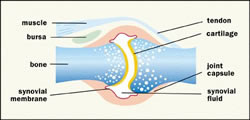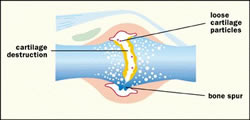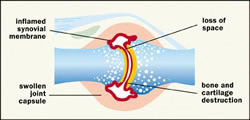|
|
|
Osteo-arthritis most often occurs at the ends of the fingers, thumbs, neck, lower back, knees, and hips.
Osteo-arthritis is the most common form of arthritis. It is a degenerative joint disease, the degenerative factor being associated with the articular cartilage and joint surfaces. Patients know this disease as old age arthritis.
In a normal joint, a smooth elastic material called cartilage covers the ends of bones where they meet. Cartilage enables the bones to glide smoothly across each other and gives joints their flexibility. When the cartilage wears away, friction in the joint leads to inflammation, weakened- tendons, ligaments and muscles that surround the joint.
This leads to the development of small bony growths, calcium spurs and soft cysts in the joints. These spurs are caused by the joints attempting to heal themselves by forming new cartilage, which unfortunately tends to form hard knobs. These knobs become bony themselves and lead to a change in the shape and structure of the joint. In reaction to the pain, muscles near the joint may become tense and contract. As muscles weaken, use of the joint may become more restricted.
All the joints in the body may be affected by osteo arthritis; however it is most commonly experienced in the weight bearing joints: knees, hips and lumbar spine. To take the hip joint as an example, the effect of continually jarring the joint in some forms of athletics could be to gradually reduce the ability of the articular cartilage to absorb shock. In time, destruction of the cartilage could occur with corresponding breakdown of joint surfaces. This theory is supported by the incidence of osteo arthritis in overweight people and athletes where normal ageing has not been the cause.
Physicians categorize cases of osteo-arthritis as primary and secondary. The primary form seems to begin by itself, with no specific cause, while the secondary type may have many causes but often results from too much stress and strain on a joint. Primary osteo arthritis occurs mostly in women and may have a hereditary component because it seems to appear more in some families than in others.
| Normal Joint |
Joint with Osteo-arthritis |
In a normal joint (where two bones come together), the muscle, bursa (sacs of fluid that protect moving muscles, skin and tendons) and tendons (tissue that attaches muscle to bone) support the bone and help the joint to move. The synovial membrane releases a slippery fluid into the joint space. Cartilage covers the ends of the bone to absorb shocks and to keep the bones from rubbing together when the joint moves.
|
With osteo-arthritis, cartilage breaks down and the bones rub together. The joint then loses shape and moves. The ends of the bone become thick, forming spurs (bony growths). Bits of cartilage or bone float in the joint space.
|
 |
 |
How is Osteo-arthritis diagnosed?
Often if a person complains of pain in joints, the physician will order X-Rays because damage on a joint can only be seen on an x ray. The history of one's symptoms and the findings of the complete physical examination also will be a valuable factor in the diagnosis. The explanation of how you feel is also important.
People with osteo-arthritis usually do not have a feeling of being ill, do not experience severe weight loss and do not have a poor appetite or fever. Also, the pain in the involved joint is usually maximal with activity (walking, etc.) and decreased by rest in patients with osteo arthritis.
What is the outlook for Osteo-arthritis?
Prompt appropriate treatment usually greatly relieves symptoms and improves function. Activity need not be permanently limited if control of the disease is maintained through the many options now available with the physicians. Researchers are constantly striving for additional means of controlling and curing the disease.
Click here to learn about the New Zealand Green Lipped Mussel Extract (GLME) - a clinially proven dietary supplement that gives relief from Osteo arthritis.
Rheumatoid arthritis is the second most common form of Arthritis. It is an inflammatory disease-though involved with joints, it is not degenerative.
It is an autoimmune disease in which the body's immune system (the body's way of fighting infection) attacks healthy joints, tissues and organs. The natural defence mechanism of the body recognizes some component of the joint lining (synovium) as an enemy and attacks it. When an immunological attack is taking place it is normally accompanied by inflammatory reaction. Inflammation of the synovial membrane may spread to other parts of the joint and the inflamed tissue may grow into the cartilage surrounding the bone ends, causing it to deteriorate. When the cartilage disintegrates, scar tissue forms between the bone ends, fusing the joint, making it rigid and difficult to move.
| Normal Joint |
Joint with Rheumatoid arthritis |
In a normal joint (where two bones come together), the muscle, bursa (sacs of fluid that protect moving muscles, skin and tendons) and tendons (tissue that attaches muscle to bone) support the bone and help the joint to move. The synovial membrane releases a slippery fluid into the joint space. Cartilage covers the ends of the bone to absorb shocks and to keep the bones from rubbing together when the joint moves.
|
With rheumatoid arthritis, the joint becomes inflamed and the synovial membrane becomes thicker. This causes the joint to swell, causing damage to bone and cartilage. Over time, the bone and cartilage gets destroyed. Space between the joint gets smaller, and the joint loses shape and moves |
 |
 |
Another reason is that the inflammation in the joint is the result of persistent infection. The organism responsible for such infection has not yet been determined but there are other cases of inflammatory conditions being caused by condition of this type.
Rheumatoid arthritis is also related to a group of substances known as prostaglandins. These are a special class of unsaturated fatty acids, which have a high level of physiological activity. They are involved in various bodily functions including ovulation, maintenance of blood pressure, smooth muscle stimulation etc. it is known that inhibition of the synthesis of certain prostaglandins in the body is affected by some anti-inflammatory drugs and also by the mussel extract. Quite possibly, these prostaglandins are influential in the inflammatory process involved in rheumatoid arthritis.
Rheumatoid arthritis is not a condition restricted to the elderly or athletes. It has no age barriers and can even affect young children. The severity of this disease can vary from the case of a person who merely suffers mild pain and stiffness in certain joints for a short period, to the case where the person is bedridden, has distorted limbs and is maintained on constant drug therapy just to control the situation.
How is Rheumatoid arthritis diagnosed?
Several laboratory tests along with a complete physical examination, a health history and X-Rays help in the diagnosis of rheumatoid arthritis. A test called the erythrocyte sedimentation rate (ESR) indicates the presence of any inflammation in the body. In this test a small blood sample is drawn; then the depth that the red blood cells sink to, in a tube in 1 hour is recorded.
Another test done with the blood sample helps to determine the presence of rheumatoid factor, an abnormal antibody present in most people who have rheumatoid arthritis. In normal conditions the presence of an antibody is nil.
What is the outlook for Rheumatoid arthritis?
Several laboratory tests along with a complete physical examination, a health history and X-Rays help in the diagnosis of rheumatoid arthritis. A test called the erythrocyte sedimentation rate (ESR) indicates the presence of any inflammation in the body. In this test a small blood sample is drawn; then the depth that the red blood cells sink to, in a tube in 1 hour is recorded.
Another test done with the blood sample helps to determine the presence of rheumatoid factor, an abnormal antibody present in most people who have rheumatoid arthritis. In normal conditions the presence of an antibody is nil.
Click here to learn about the New Zealand Green Lipped Mussel Extract (GLME) - a clinially proven dietary supplement that gives relief from Osteo arthritis.
Disclaimer: This is not to provide medical advice. All content including text, graphics, images and information is for general informational purposes only.
|
 Call 8010-222-777
Call 8010-222-777






